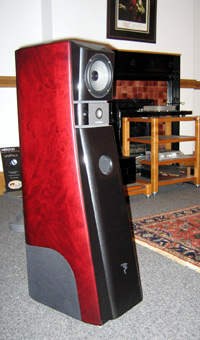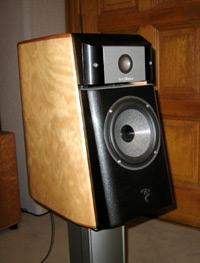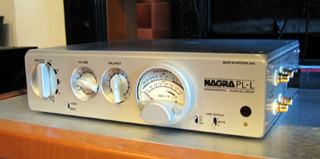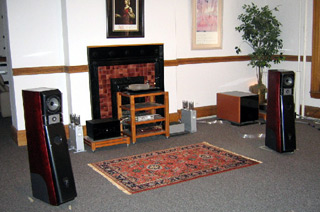![[SoundStage!]](../sslogo3.gif) The Candy Store The Candy StoreBack-Issue Article |
||
June 2004 All in a Day's Work -- Sometimes It all started innocently enough. Jeff, one of my partners in crime, mentioned that he had set up a system in our big listening room upstairs, and that I may want to give it a listen.
I knew that Jeff had been tinkering with the Quad 989s, but I also knew that they weren’t really my cup of tea. Yes, the Quads have that amazing speed and transparency in the midrange; with that I will concur. If I try to describe the sound of the 989s, I really can’t find much to fault. They’re extremely neutral, highly resolving, and throw a deep, wide soundstage. Perhaps they are just too neutral for me. I prefer my glasses rose-tinted, if only slightly. I guess I’m just not a electrostat kind of guy. Jeff, on the other hand, loves electrostats and planars. He owns at least three pairs of Maggies and lusts after any speaker that looks like a tall room partition or portable bulletin board -- or so I tease. Actually it’s quite nice to have people in the store who have varied tastes and experience. It’s a win-win situation for customers. I needn’t have worried. Walking into the room, I found, not the Stanley Kubrick-inspired black monoliths, but the beautifully understated Focal.JMlab Diva Utopia Be's ($11,500 USD per pair). At only 43" tall and a little less than 10" wide, the Divas looked tiny in the cavernous 36' by 24' room with a 12' ceiling. The usual suspects for this room have included such giants as Wisdom Audio ribbons, Sound Lab Ultimates, and the most-recent tenants, Dali Megalines. Speakers of this stature really enjoy the space afforded by this room -- space seldom seen in an audio salon. For a fair audition these guys need the breathing room. The little Divas, on the other hand, were almost lost, at least visually. The Divas were not the first of the new Beryllium-series Utopia line to find a home in our store. Months earlier we received in a pair of the Micro Be's and fell hard. These little beauties can resolve as well or better than any speaker out there at any price. We have a soft spot for minimonitors, so they became a favorite and have found an almost permanent position set up in one of our listening rooms. The pinpoint imaging, the wrap-around soundstage, and that great minimonitor disappearing act -- this speaker is one of a handful of reference minimonitors. The Micro Be also has excellent bass for a minimonitor, but adding a REL Storm sub to the equation created a seamless full-range system. Among the amplifiers that really groove with the Micro Be's are the Conrad-Johnson Premier 140, the YBA Passion Intégré, the Brinkmann, and various McCormack amplifiers. A traveling pair of Nova Utopia Be's also spent a week or two in our large listening room. The visit was brief and we never really seemed to find the right combination of placement, amplifier and cable. There was certainly a hint of something amazing, but the affair ended too quickly. Aesthetically, the Diva Be's are gorgeous. Tall and slender, yet solid, the Divas have the stature of a professional dancer. Only a 6 1/2" inch midrange and that amazing beryllium inverted-dome tweeter decorate its face. The long, sloping front baffle, painted in a slate-gray metallic lacquer, provided a look of simple elegance. At the base, on each side of the cabinet, is an 8" bass driver hidden behind an unusually shaped grille. Both the midrange and bass drivers use the W-cone technology, bonding two very thin tissues of glass fiber to a central foam layer. The resulting drivers are extremely light, fast, and expensive -- they cost ten times as much as quality paper drivers. A single pair of WBT binding posts adorns the back. When the Diva Be's arrived, our expectations were already too high to be fair. As with a movie whose gripping trailers have been enticing you for months, we were expecting the moon. We set up the Divas in one of our more average-sized listening rooms (17' x 22') and prepared to be wowed. We tried a variety of amplifiers ranging from the refined Thor TPA-30 tube monoblocks to the dynamic Edge M8 solid-state amp. The speakers easily showcased the differences and provided really good sound. That’s what we’re looking for, right? The Divas did provide that same resolution, transparency, and refinement that the Micros excelled at, and they also added a very nice, fleshed-out bottom end. They would be a great speaker in anyone’s book. In this same room we also regularly audition the Dynaudio C-2. The C-2s also provide really good sound at about the same price. The Dynaudios paint the picture with a slightly different stroke. The bass is a little faster, but not as full. The highs are a little sweeter, but not as detailed. Both speakers provide the quality of sound you would expect for their price. This was the sound I was pleasantly remembering when I saw the Diva Be's waiting for me in the more expansive room.
The room wasn’t the only change. The speakers were connected up to our Nagra VPA tube monoblocks. At just under $20,000 per pair, these pure class-A 50-watt triode push-pull monoblocks are the best our store can offer. They ooze quality and are beautiful to behold in that "1950s medical equipment look" kind of way. Only lacking in ultimate power, there are few amplifiers I have heard that equal the VPAs in terms of providing a convincing musical experience. Controlling the VPAs was the Nagra PL-L line-stage preamplifier ($7500). The source was all analog: an Amazon Model Two turntable ($4000) with the amazing Schroeder Model One tonearm ($3900) and hand-built Allerts MC 1S moving-coil cartridge ($3000). The phono stage was the Art Audio Vinyl Reference ($4000). Cabling was all Nordost Valhalla. Let’s just say that this system didn’t suck. I was sure that the speakers would get lost in the room and that the bass would be nonexistent. The speakers were pulled out from the front wall about 6' and were about 8' apart with the same distance to the side walls. The listening position was about 8' from each speaker. I looked into my little black bag of vinyl for the first record and was ready to be unimpressed. The first LP was the Classic Records reissue of Mussorgsky’s Pictures at an Exhibition conducted by Fritz Reiner [Classic Records LSC-2201-200]. I cued up the first track, "Promenade," and waited. I have to say that I was so startled by the music when it started that I visibly jumped. I’m sure Jeff, who was sitting directly behind me, got quite a chuckle. The music seemed to jump from the space in front of me. The orchestra was as wide as the room, and I heard the reflection of the hall roll down the walls. But it was so much more than that. The sound was nearly visual. I don’t remember when I have heard reproduced music sound so real. Sitting in the listening chair, I didn’t have to stretch to "see" each individual violinist drawing his bow across the strings. I felt like I could walk up and assist the percussion section, take a few whacks at the tympani myself. Changing records, I put on Michael Hedges' Aerial Boundaries [Windham Hill WD-1032]. Acoustic guitar is always very telling to me, and Hedges was one of the best guitarists. Again, I found myself transfixed by the immediacy of Hedges' playing. This recording is very dynamic. Anyone who was lucky enough to see Hedges in concert knows that he was not kind to the guitar strings. As individual strings were plucked, the notes shot through the air like bullets. Damn! For a taste of vocals, I put on The Weavers' Live at Carnegie Hall, an original Vanguard pressing [Vanguard VSD-76533]. This recording really puts you in the audience, complete with sing-a-longs and the occasional cough. Again, I can't stress enough how visual the sound was. Each member was standing very precisely on stage. During "Good Night Irene," I found my head turning as each person sang in turn across the stage. The sound was too good, and it was beginning to anger me. I have a very good system at home and have never had a problem going back to it after listening to any system at the store. Until now. I knew I couldn't come close to reproducing what I was hearing. I also knew I couldn’t come close to affording what I was hearing. I was being ruined.
I wish I could say it was only me. I wish I could say that it only happened on that day, when the planets and power grid aligned just so. It may have been the amps and the system synergy. It may have been the amazing analog rig. I suspect the room had a lot to do with it. Oh, for such a listening room. But in days to come some very good ears found their way into that room. None wanted to leave. One of our regulars, I’ll call him Mr. Particular, came down the other day, just to hear what was gaining a reputation as "the system." Mr. P. always has some criticism, always finds fault with a certain speaker or component with which we have become enamoured. I played record after record for Mr. P. until at last he spoke. His words said it all: "That’s the way it’s supposed to sound." ...Bill Brooks |
||
|
||
![[SoundStage!]](../sslogo3.gif) All Contents All ContentsCopyright © 2004 SoundStage! All Rights Reserved |



 I finally put on a record that
I thought would sound only average, Frank Sinatra’s, Moonlight Sinatra
[Reprise 2-1018]. I’ve always loved this record, but it never had that
"he’s in the room" kind of feel. I wanted it to fail. I wanted to hear
something that was good, but not too good. Cued up "Reaching for the
Moon" and -- damn. Where there should have been a turntable there was only
Frank, drink in one hand and cigarette in the other. I could hear the ice melting in his
glass as he stepped up to the microphone. Turn it off, throw everything out the window,
burn down the building. I’m done.
I finally put on a record that
I thought would sound only average, Frank Sinatra’s, Moonlight Sinatra
[Reprise 2-1018]. I’ve always loved this record, but it never had that
"he’s in the room" kind of feel. I wanted it to fail. I wanted to hear
something that was good, but not too good. Cued up "Reaching for the
Moon" and -- damn. Where there should have been a turntable there was only
Frank, drink in one hand and cigarette in the other. I could hear the ice melting in his
glass as he stepped up to the microphone. Turn it off, throw everything out the window,
burn down the building. I’m done.